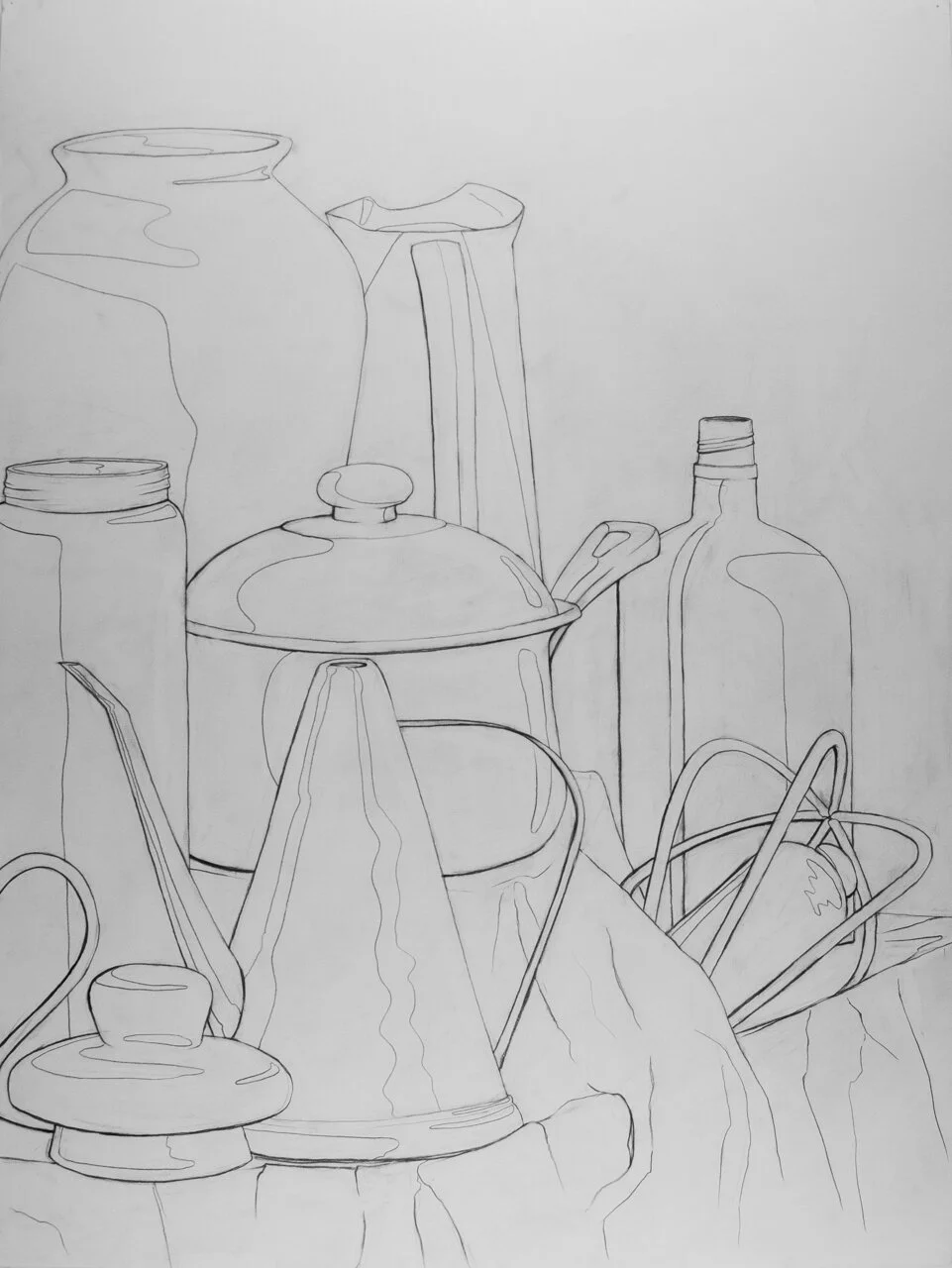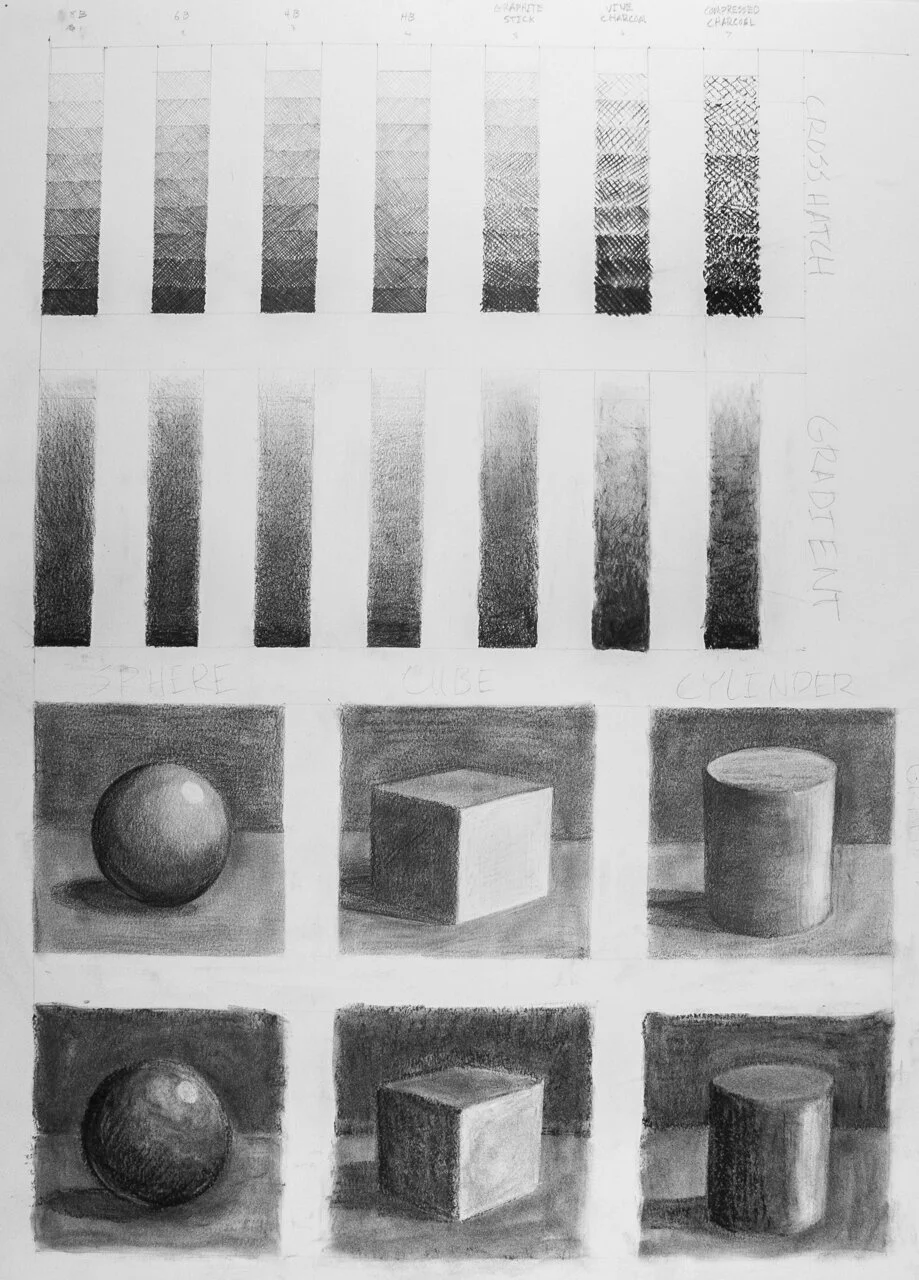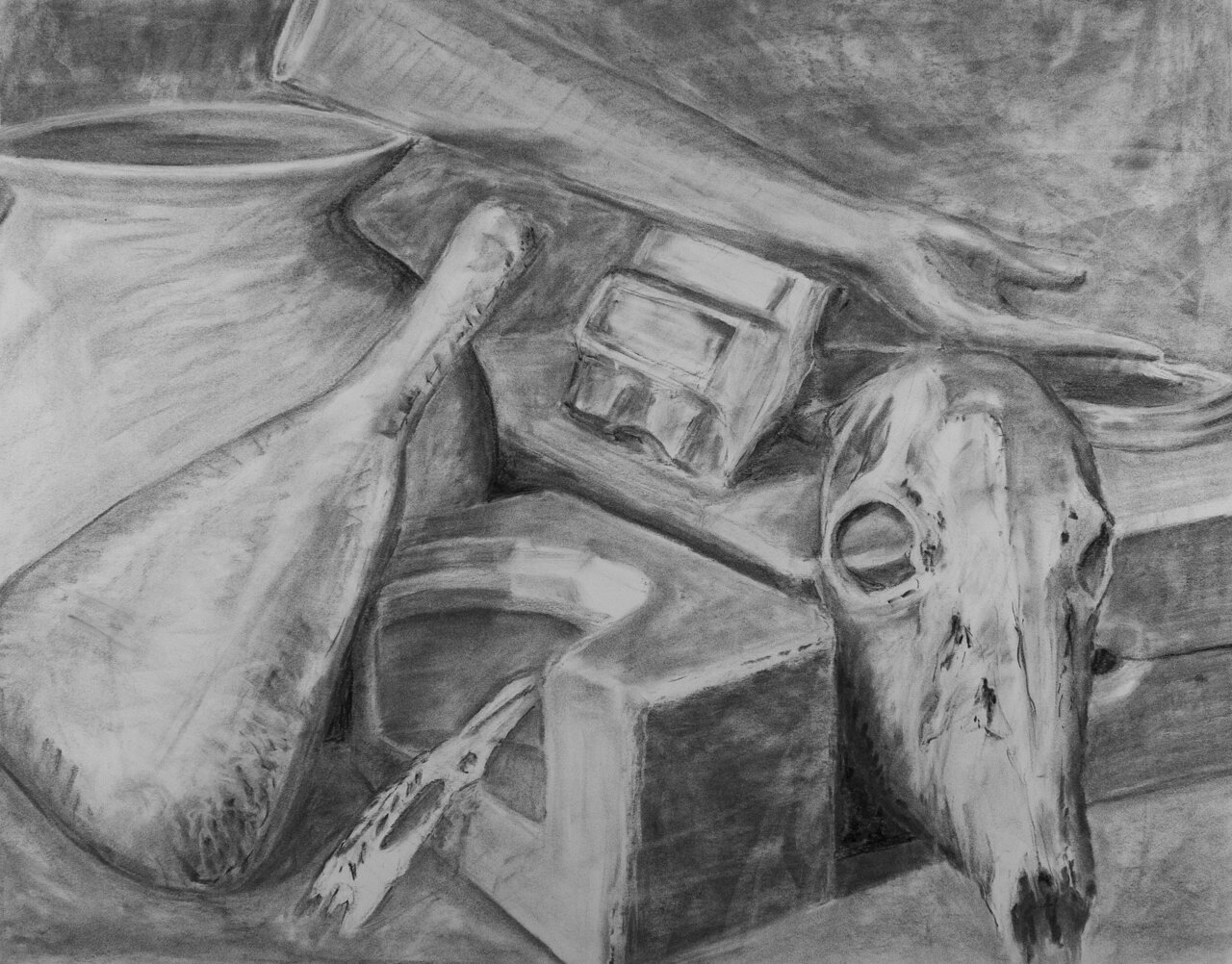
Technique: Charcoal, india ink, cut paper
Each composition 12”x9”, 2019
Prompt: Choose three distinct shapes and duplicate them at various sizes, alternating between black, grey, and white. Collage together to create three compositions that demonstrate the Gestalt Principles as well as the Elements and Principles of Design. For each composition, write a paragraph describing how you used at least one Gestalt Principle, Element of Design, and Principle of Design.

Technique: Letraset, laser-cut paper, letterpress pressure printing, letterpress typesetting
Each print 12"x9", 2019
Objectives: Work with letterforms to create abstract compositions, establish a relationship between foreground text and background image, and blend analog and digital processes.
Prompt: First, create abstract compositions using Letraset dry transfers. Then, scan your compositions, vector trace, and use the laser cutter to cut out of different thicknesses of paper. These paper stencils will be placed behind your printing paper on the letterpress to create pressure prints. Lastly, set type for a phrase that reflects the mood of your compositions and print over top.

Technique: Reductive three-layer monoprint (Ink is rolled onto plexiglass with a brayer and wiped away with q-tips and rags. Colors are then printed in overlapping layers on the same sheet of paper. )
9”x12”, 2018
Prompt: Using a drawing as reference, design and print three color layers (yellow, magenta, and cyan) that are registered correctly to mimic your drawing and overlap to create six colors total.

Technique: monoprint using paper stencils, paintbrushes, and brayers on Plexiglas plate
Each print 15”x11”, 2018
Prompt: Utilize Elements and Principles of Design and try at least three different monoprint techniques.

Technique: Graphite Pencil
19"x24", 2019
Prompt: Choose a composition using your viewfinder. Use sighting techniques to place objects on the page. Pay attention to proportion and spatial relationships between objects. Map out each object using expressive contour line. Use line variation to hint at tonal shifts and to describe the weight, mass, and form of the object.

Technique: Graphite Pencil
2019, 19"x24"
Prompt: Draw (from life) a still life of 5 objects with curved surfaces. Make thoughtful decisions about dominant and secondary shapes and positive/negative space. Use cross contour line to depict each object volumetrically. The lines should follow the curvature of the form to depict a 3D object. Use sighting techniques to depict spatial relationships accurately. Use line variation / sensitive line.

Technique: Graphite & Charcoal
24"x19", 2019
Value scales: Two rows of 1" x 5" value scales with 1" between each scale. Each scale divided into 1/2" increments. One row of scales should use tonal (smooth) shading. Do one scale for each of the following: 8b, 6b, 4b, hb, graphite stick, vine charcoal, compressed charcoal. The second row will include the same materials, but will use crosshatching instead of tonal shading
Geometric Solids: Grid of six 4.5" x 4.5" squares. 1/2" of space between each square. Draw from life (models are set up in the studio). Use lamp for directional light. Row 1: Compressed charcoal with tonal shading. Draw a sphere in the first square, cube in the second, cylinder in the third. Include a horizon line for each. Row 2: Graphite with tonal shading. Square, cube, cylinder; horizon line for each.

Technique: Ballpoint Pen
12”x18”, 2019
Prompt: Draw the same object from six different angles. Keep drawing until your pen runs out of ink.

Technique: Charcoal
18"x24", 2019
Prompt: Choose a composition using your viewfinder. Use sighting techniques to place objects on the page. Pay attention to proportion and spatial relationships between objects. When building value, consider the composition as a whole using a general-to-specific approach. Consider highlights, shadows, reflected light, and cast shadows.

Technique: Graphite
24”x19”, 2019
Prompt: Create a hybrid animal based on studies of taxidermy specimens drawn from life at the Natural History Museum and invent a landscape for your creature to live in. This assignment teaches students to combine imagery from multiple references and also helps them practice working with value and texture.

Technique: Charcoal, combining additive and reductive drawing methods
24”x19”, 2019
Prompt: Self-portrait with exaggerated facial expression. Your other decisions for the image (background, clothing/costume, stylistic decisions) should complement and support the emotion that is the theme of your drawing. Make sure your drawing demonstrates fully-developed tonal shading and correct sighting and proportions for portraiture, using the strategies we’ve practiced in class.

Technique: Graphite
24"x19", 2016
Prompt: Use the life drawing techniques we learned in class to draw from an image of a figure in motion. Pay attention to proportions, distribution of weight, and direction of axis lines to create a believable depiction of gravity and movement. Use a combination of line variation and tonal shading.

Technique: charcoal and white chalk on oversize kraft paper.
4 foot x 6 foot, 2019
Prompt: Work in groups of 3 to build a 2-point perspective structure from your imagination. Decide as a group whether you want to construct an interior space (like a room), an exterior space (like a cityscape), or an abstract composition of geometric solids (3D shapes.) Once you have mapped out the forms, decide on an imagined light source and shade the whole composition using a full tonal range.

Technique: Silkscreen
Installation size: each wallpaper at least 36 square feet, 2019
Prompt: Students will explore the basics of silkscreen printing while designing repeating patterns. Their wallpaper patterns will come together in a collaborative large-scale installation. The workshop will take inspiration from contemporary artists like Virgil Marti and Renee Green whose use of pattern goes beyond the decorative and creates a viewer experience that is not only immersive but that also contains elements of narrative. We will also discuss the usefulness of the multiple in creating large-scale artworks. (The opening reception was attended by over 150 visitors. For many of the students, this was their first time discussing their work with viewers at an art opening.)

Technique: Linocut
24’x2’ installation, 2018
Prompt: Each student will design, carve, and print one building and one other object that might be found in a city. We will each print an edition of 5, and then cut out and collage our prints to create an imaginary skyline. We will work as a team to create a successful composition for the final skyline that takes both negative and positive space into consideration.

Technique: Linocut
Detail of 24’x2’ installation, 2017
Prompt: Each student will design, carve, and print one building and one other object that might be found in a city. We will each print an edition of 5, and then cut out and collage our prints to create an imaginary skyline. We will work as a team to create a successful composition for the final skyline that takes both negative and positive space into consideration.

Technique: polyester lithography plate with laser-printed halftone, ballpoint pen, and sharpie. Hand-colored.
7”x10”, 2018
Prompt: Combine digital and hand-drawn imagery to create a narrative.

Technique: Aluminum plate lithography with silkscreen color layers
22”x15”, 2018
Prompt: Research and respond to a theme in contemporary art. Students were provided with a list of themes and related resources and asked to fill out a worksheet that functioned as a precursor to an artist statement. As an ideation exercise, they answered questions under headings of, "previous work, personal experience, research & reference, contemporary & historical context, artistic influence, and personal goals." This student’s chosen theme was “The Body.”

Technique: Seven-Layer Reductive Woodcut
15” x 11”, 2018
Prompt: This project is a woodcut image based on a song lyric, with colors chosen to reflect the mood of the song. The song this student referenced was You’re So Vain by Carly Simon.

Technique: 3D collage using cardboard, paper, acrylic paint, and Mod Podge.
12”x12”x5”, 2019
Prompt: Research an artist, present to the class, and create an artwork inspired by your research. The finished work should reference the artist without being a direct master copy.
(This student chose Vincent Van Gogh and used a familiar image from art history to explore ways of blurring the lines between 2D and 3D media)




















Technique: Charcoal, india ink, cut paper
Each composition 12”x9”, 2019
Prompt: Choose three distinct shapes and duplicate them at various sizes, alternating between black, grey, and white. Collage together to create three compositions that demonstrate the Gestalt Principles as well as the Elements and Principles of Design. For each composition, write a paragraph describing how you used at least one Gestalt Principle, Element of Design, and Principle of Design.
Technique: Letraset, laser-cut paper, letterpress pressure printing, letterpress typesetting
Each print 12"x9", 2019
Objectives: Work with letterforms to create abstract compositions, establish a relationship between foreground text and background image, and blend analog and digital processes.
Prompt: First, create abstract compositions using Letraset dry transfers. Then, scan your compositions, vector trace, and use the laser cutter to cut out of different thicknesses of paper. These paper stencils will be placed behind your printing paper on the letterpress to create pressure prints. Lastly, set type for a phrase that reflects the mood of your compositions and print over top.
Technique: Reductive three-layer monoprint (Ink is rolled onto plexiglass with a brayer and wiped away with q-tips and rags. Colors are then printed in overlapping layers on the same sheet of paper. )
9”x12”, 2018
Prompt: Using a drawing as reference, design and print three color layers (yellow, magenta, and cyan) that are registered correctly to mimic your drawing and overlap to create six colors total.
Technique: monoprint using paper stencils, paintbrushes, and brayers on Plexiglas plate
Each print 15”x11”, 2018
Prompt: Utilize Elements and Principles of Design and try at least three different monoprint techniques.
Technique: Graphite Pencil
19"x24", 2019
Prompt: Choose a composition using your viewfinder. Use sighting techniques to place objects on the page. Pay attention to proportion and spatial relationships between objects. Map out each object using expressive contour line. Use line variation to hint at tonal shifts and to describe the weight, mass, and form of the object.
Technique: Graphite Pencil
2019, 19"x24"
Prompt: Draw (from life) a still life of 5 objects with curved surfaces. Make thoughtful decisions about dominant and secondary shapes and positive/negative space. Use cross contour line to depict each object volumetrically. The lines should follow the curvature of the form to depict a 3D object. Use sighting techniques to depict spatial relationships accurately. Use line variation / sensitive line.
Technique: Graphite & Charcoal
24"x19", 2019
Value scales: Two rows of 1" x 5" value scales with 1" between each scale. Each scale divided into 1/2" increments. One row of scales should use tonal (smooth) shading. Do one scale for each of the following: 8b, 6b, 4b, hb, graphite stick, vine charcoal, compressed charcoal. The second row will include the same materials, but will use crosshatching instead of tonal shading
Geometric Solids: Grid of six 4.5" x 4.5" squares. 1/2" of space between each square. Draw from life (models are set up in the studio). Use lamp for directional light. Row 1: Compressed charcoal with tonal shading. Draw a sphere in the first square, cube in the second, cylinder in the third. Include a horizon line for each. Row 2: Graphite with tonal shading. Square, cube, cylinder; horizon line for each.
Technique: Ballpoint Pen
12”x18”, 2019
Prompt: Draw the same object from six different angles. Keep drawing until your pen runs out of ink.
Technique: Charcoal
18"x24", 2019
Prompt: Choose a composition using your viewfinder. Use sighting techniques to place objects on the page. Pay attention to proportion and spatial relationships between objects. When building value, consider the composition as a whole using a general-to-specific approach. Consider highlights, shadows, reflected light, and cast shadows.
Technique: Graphite
24”x19”, 2019
Prompt: Create a hybrid animal based on studies of taxidermy specimens drawn from life at the Natural History Museum and invent a landscape for your creature to live in. This assignment teaches students to combine imagery from multiple references and also helps them practice working with value and texture.
Technique: Charcoal, combining additive and reductive drawing methods
24”x19”, 2019
Prompt: Self-portrait with exaggerated facial expression. Your other decisions for the image (background, clothing/costume, stylistic decisions) should complement and support the emotion that is the theme of your drawing. Make sure your drawing demonstrates fully-developed tonal shading and correct sighting and proportions for portraiture, using the strategies we’ve practiced in class.
Technique: Graphite
24"x19", 2016
Prompt: Use the life drawing techniques we learned in class to draw from an image of a figure in motion. Pay attention to proportions, distribution of weight, and direction of axis lines to create a believable depiction of gravity and movement. Use a combination of line variation and tonal shading.
Technique: charcoal and white chalk on oversize kraft paper.
4 foot x 6 foot, 2019
Prompt: Work in groups of 3 to build a 2-point perspective structure from your imagination. Decide as a group whether you want to construct an interior space (like a room), an exterior space (like a cityscape), or an abstract composition of geometric solids (3D shapes.) Once you have mapped out the forms, decide on an imagined light source and shade the whole composition using a full tonal range.
Technique: Silkscreen
Installation size: each wallpaper at least 36 square feet, 2019
Prompt: Students will explore the basics of silkscreen printing while designing repeating patterns. Their wallpaper patterns will come together in a collaborative large-scale installation. The workshop will take inspiration from contemporary artists like Virgil Marti and Renee Green whose use of pattern goes beyond the decorative and creates a viewer experience that is not only immersive but that also contains elements of narrative. We will also discuss the usefulness of the multiple in creating large-scale artworks. (The opening reception was attended by over 150 visitors. For many of the students, this was their first time discussing their work with viewers at an art opening.)
Technique: Linocut
24’x2’ installation, 2018
Prompt: Each student will design, carve, and print one building and one other object that might be found in a city. We will each print an edition of 5, and then cut out and collage our prints to create an imaginary skyline. We will work as a team to create a successful composition for the final skyline that takes both negative and positive space into consideration.
Technique: Linocut
Detail of 24’x2’ installation, 2017
Prompt: Each student will design, carve, and print one building and one other object that might be found in a city. We will each print an edition of 5, and then cut out and collage our prints to create an imaginary skyline. We will work as a team to create a successful composition for the final skyline that takes both negative and positive space into consideration.
Technique: polyester lithography plate with laser-printed halftone, ballpoint pen, and sharpie. Hand-colored.
7”x10”, 2018
Prompt: Combine digital and hand-drawn imagery to create a narrative.
Technique: Aluminum plate lithography with silkscreen color layers
22”x15”, 2018
Prompt: Research and respond to a theme in contemporary art. Students were provided with a list of themes and related resources and asked to fill out a worksheet that functioned as a precursor to an artist statement. As an ideation exercise, they answered questions under headings of, "previous work, personal experience, research & reference, contemporary & historical context, artistic influence, and personal goals." This student’s chosen theme was “The Body.”
Technique: Seven-Layer Reductive Woodcut
15” x 11”, 2018
Prompt: This project is a woodcut image based on a song lyric, with colors chosen to reflect the mood of the song. The song this student referenced was You’re So Vain by Carly Simon.
Technique: 3D collage using cardboard, paper, acrylic paint, and Mod Podge.
12”x12”x5”, 2019
Prompt: Research an artist, present to the class, and create an artwork inspired by your research. The finished work should reference the artist without being a direct master copy.
(This student chose Vincent Van Gogh and used a familiar image from art history to explore ways of blurring the lines between 2D and 3D media)